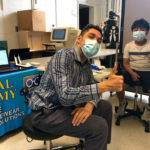
Dr. Mena with a young patient. Dr. Mena’s practice has pediatrics as one of its niches, with many of these patients receiving myopia management services. This is a growing practice area, which Dr. Mena has been learning more about through continuing education.
By Vittorio Mena OD, MS
Sept. 8, 2021
Continuing education helps you be a better doctor, and it can also help you build your practice. Here are three CE courses that not only helped me provide better care, but grow a more profitable practice, too.
Establishing Sports Vision in Your Practice
Presented as a part of the 2020 International Sports Vision Association Annual Conference, this course explained how and why each patient we encounter can be considered an athlete.
Patients all have hobbies outside of work–bicycling, tennis, softball leagues, running and fishing, among other activities. Eye-hand coordination is important to each sport or activity. Every optometrist is capable, at the very least, of prescribing contact lenses, sports goggles, safety eyewear and swim goggles. We can also can discuss the importance of eye/head injuries, and let patients know that when an incident like this occurs, the optometrist should be the first doctor they contact instead of heading to the emergency room and waiting hours to be seen.
This course coincided with research I started doing into additional investments I could make to strengthen the sports vision services I provide. I began learning about technologies such as RightEye, Neurotracker, Binovi, FitLight Trainer, Senaptec Strobe glasses, Senaptec Sensory Station, pitch recognition balls, balance boards and peripheral awareness charts. By implementing these technologies into your practice, you differentiate yourself from competitors and add fun to your workday.
These services are usually out-of-pocket for the patient, and can grow your practice with patients and revenue. The course taught us the importance of seeking out patients-athletes who may need our services by learning more about our local community. This is as simple as doing a Google search for travel soccer and travel baseball, tennis or baseball academies or sports performance centers “near me.”
You also can reach out to the sports departments of high schools and colleges nearest to your practice. This course helped me understand how to have discussions with coaches, athletic trainers and athletic directors.
These kinds of sports vision classes sometimes come with valuable workshops, especially at AOA Optometry’s Meeting, in which you are shown how to conduct sports vision assessment tests and integrate these tests into your practice.
My sports vision services result in around $75,000 generated annually. Those profits stem from sales of contact lenses, sports goggles and the nutraceutical VIZION EDGE.
How To Add Myopia Management Without Losing Your Mind, Your Staff and Your Primary Care Practice
Presented by Review of Myopia Management, this course showed attendees how to launch a myopia management practice and how to handle discussions with both the parent and the child. Most parents who never wore glasses or contact lenses do not understand what “myopia” means. This course emphasized the importance of teaching parents about this term as a first step to getting them to appreciate the importance of myopia management.
The course also taught me how to educate parents about the threat to eye health posed by myopia, including glaucoma, cataracts, retinal detachments and myopic maculopathy.
The second key discussion covered by the course is educating parents on how myopia can be managed. In my practice myopia management includes prescribing the multifocal center distance NaturalVue Multifocal 1 Day Contact Lenses or the FDA-approved MiSight 1 day from CooperVision or the option of low-dose Atropine ophthalmic drops. In my practice I do not do orthokeratology, so when a patient prefers this option, I will refer to a fellow colleague who specializes in that.
I learned that all ODs have the responsibility to educate parents about the risks of myopia and the options available to manage it. If we decide not to do it ourselves we should be at least referring out to someone who can help young patients with myopia. You want to treat each patient like a member of your family and give them the best care possible. We are treating the person, not just myopia.
Adding myopia management to your practice will lead to better-cared-for patients and potential revenue growth. For example, you can charge a patient as little as $1,000 for fitting in MiSight lenses and make a profit of $250. However, if you were to charge $2,500, then your profit would be $1,750. On average, the cost to the patient for MiSight lenses is $1,250-$2,500 depending on your geographic area and your expertise level. Profitability is slightly higher with NaturalVue since the cost of the lens is less to the practice.
Nutritional & Lifestyle Modifications To Reduce Risk of AMD Onset and Progression
This course, presented at this year’s AOA Optometry’s Meeting in Denver, showed attendees how to minimize our patients’ chances of developing macular complications. We were shown how to educate staff and patients about the link between nutrition and lifestyle and risk to eye health. If you had an expensive sports car, you probably would provide it with premium gas and regular engine checks as opposed to just regular gas and occasional engine checks. This course showed me how to explain to patients that this same principle applies to their body, and the importance of fueling their bodies with a good diet and frequent exercise.
Other Articles to Explore
I now know how to explain to patients the importance to both overall health and eye health of eating leafy green vegetables like broccoli, spinach and kale. I explain how nutrients, such as zeaxanthin, lutein and meso-zeaxanthin, which can be found in fruits and vegetables and other foods, are important to eye health. The course taught me to teach my patient that when those three carotenoids are taken together in supplement form it will ultimately lead to better visual results, such as better contrast sensitivity, which minimizes glare and allows for quicker visual adaptation.
This course helped me introduce the sale of eye vitamins in my practice. I now prescribe VIZION EDGE, a supplement that contains a high amount of zeaxanthin and lutein, as well as meso-zeaxanthin.
These vitamins typically come in a case of 24. In the first month of prescribing these vitamins, a total of five cases of VIZION EDGE were purchased for the practice with four cases sold in just four weeks!
There are 30 soft gels in each VIZION EDGE bottle, which last patients one month as they take it once a day. The cost to the practice on each bottle is $13-$15. The profit to the practice per bottle is around $15. EyePromise Vizual Edge PRO comes in a case of 10 and the cost to the practice is $450. Profit on each patient is about $30-$35 per box.
In addition to the importance of nutrition, the course covered how to talk to patients about lifestyle modifications such as quitting smoking, which can reduce a patient’s risk of developing macular degeneration.
As healthcare practitioners, we should always educate our patients on nutrition, lifestyle modifications and vitamins that will benefit both their general health and eye health, helping them lead better lives.
 Vittorio Mena OD, MS, is the sports vision director with Optical Academy. To contact him:menavitt@gmail.com
Vittorio Mena OD, MS, is the sports vision director with Optical Academy. To contact him:menavitt@gmail.com

























